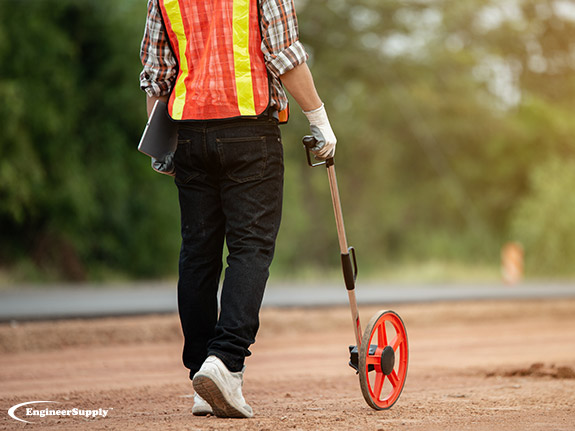What is linear surveying? What purpose does it serve?


Distance measurement is considered to be the most fundamental of all surveying operations. Surveyors are concerned about measuring both horizontal and vertical distances. And while many angles are read, surveyors need to determine the length of at least one line to supplement them at specific locating points. This is the purpose of linear surveying. It involves using
survey equipment to measure the distance between two points on the Earth’s surface, which can be accomplished in different ways (depending on the level of accuracy required).
Types of Linear Surveying
The methods for linear surveying can be defined into three basic categories:
- Direct Measurement— In this method, the distance is directly measured through the use of chains, tapes, and other types of surveying equipment. It’s the oldest and simplest method because it doesn’t need any technical survey instruments, but it can be hard to measure longer distances. It’s also impractical in dangerous environments (such as swamps, when surveying across rivers, as well as in chasms and other inhospitable locations).
- Optical Measurement— With this method, surveyors make observations through a telescope while the distance is determined through the use of a process known as “triangulation.” While it doesn’t rely on expensive electronics, it does depend on light waves because it involves the use of some kind of optical survey equipment. It also requires excellent skills in mathematics, because the surveyor needs to calculate the distance between two points from raw data.
- Electronic Measurement— With this method, distances are measured with survey instruments that depend on the propagation, reflection, and reception of radio or light waves. Surveyors use equipment that will generate waves, reflect them back, and calculate the distance based on that reflection. Surveying with light waves involves a geodimeter, which emits a laser beam and measures based on how it reflects back to the device. Other types of surveying equipment (such as a tellurometer) use radio waves to measure distance.
The primary instrument that many surveyors use on a job site is the total station. It combines the angle measurements that can be gathered with a theodolite with the functionality of an electronic distance meter. Because of their limitations, using tapes and chains to perform linear surveying has become obsolete for all baseline measurements. With modern
survey equipment, distances can be measured more easily and with greater accuracy (regardless of terrain conditions). Modern total stations have algorithms that can reduce the slope distance to its horizontal and vertical components. And for engineering surveys, having
surveying equipment with automatic data logging has become the standard.
By using today’s equipment, the typical time it takes to measure distance is 1.5 to 3 seconds. And in tough atmospheric conditions, using automatic repeated measurement can be used to improve reliability. You can also measure over greater distances with much better control of swing errors. To find a variety of
survey equipment you can use to perform a linear survey, be sure to look at what we have at Engineer Supply. We’re sure you’ll be able to find a product that will meet your specific needs.

Frequently Asked Questions
When do I need to perform a land survey?

Land surveys are necessary for finding property lines and for determining the location of its features. Without them, there would be no way to know where one piece of land ends and where another one begins. Some of the reasons to perform a land survey include but may not be limited to:
- Determining property lines.
- Meeting certain mortgage requirements.
- Getting title insurance.
- Settling boundary line disputes.
- Building a house or some other structure.
- Updating an outdated property survey.
- Locating utility lines.
Knowing the approximate location of property lines might be good enough if you want to know how far you should go when you mow the lawn. But when it comes to building permits and lending, you may need to do a more detailed land survey so you can find out exactly where your boundary lines are.
How do I perform a property survey?
Also called a boundary survey, a property survey involves the precise measurement of the boundary lines around a specific piece of land, which is important for building additions to your home. While many places require a property survey, it’s not mandatory everywhere. But it can be beneficial to have an official document that details all the land boundaries in case there’s a neighborly dispute or any other inconvenience.
What kind of equipment is used in surveying?
Surveying has been around for hundreds (if not thousands) of years, and some of the survey equipment used today has been around for centuries. While the technology behind them has improved, their basic functions haven’t changed. Some of the most common types of instruments used in surveying include:
- Theodolites— While they’re rarely used in this day and age, they preceded many types of modern survey instruments. They can measure angles along the horizontal and vertical planes, and they can do it with a great deal of accuracy.
- Total Stations— These are more comprehensive versions of theodolites. They have the same functions but with the technology of an electronic distance meter (EDM). They also have microprocessors that can store data, which can be handy for any number of surveying projects.
- Survey Drones— These tools are being used more and more for surveying large areas, roofs, and other areas that would otherwise be inaccessible. They can be good for obtaining photographic records, and point cloud information can also be produced to work terrestrial laser scanning.
- Transit Levels— These are the simplest of all the survey instruments, but they’re still useful. They can be used for both surveying and building, which is a testament to their versatility.
Feel free to look at the broad selection of
surveying equipment we have at Engineer Supply.
How does surveying equipment work?
Survey instruments can help surveyors and engineers to accurately measure certain things (such as angles, elevations, and boundaries). With these tools, they can get more precise results in a much faster and less tedious manner. Feel free to look at what we have at Engineer Supply.
Can I rent survey equipment?
There is a variety of
surveying equipment, and each one can be suitable for a specific purpose. You may not need the functionality of a GPS if you survey a lot of homes located in wooded areas with no GPS signal, but it may be hard to know exactly what you need without trying out different survey instruments. Renting them beforehand can help you decide which ones will meet your specific needs.
Feel free to look at the broad selection we have at Engineer Supply.
How Does Surveying Work
Related Survey Equipment Articles